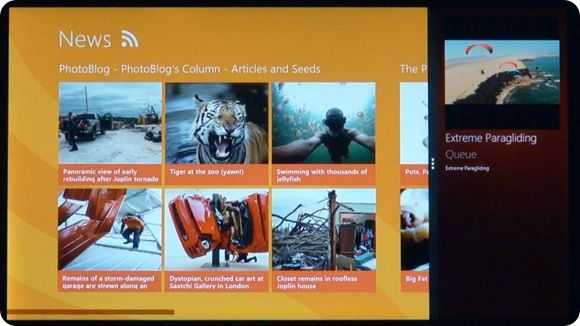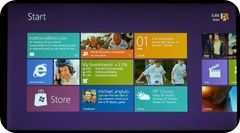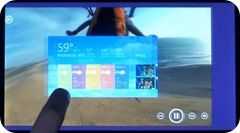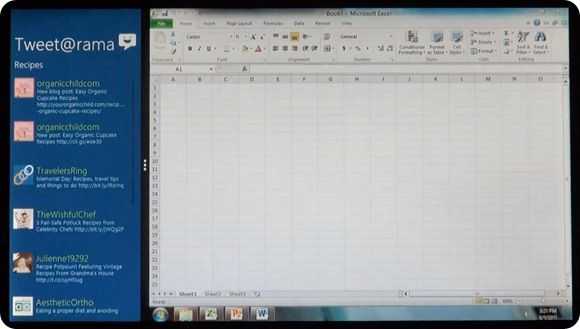There’s lots to learn from the demonstrations and information on Windows 8 from the last few days. Not only from Microsoft themselves but through the reactions and thoughts of commentators. I’ve given it some time, made some notes and am ready to put my thoughts down.These are the thoughts of someone that’s used tablets in both the commercial and consumer world, someone that loves social networking but someone that also knows how important Windows is for getting things done.
First and foremost, we must remember how important the desktop is to Microsoft. We can talk about tablet and touch all day but the fact is that Microsoft need to deliver a backward-compatible operating system, somehow. Having said that, I’m surprised that Microsoft didn’t talk about splitting the old from the new and going along two tracks. Or perhaps they did…
Windows 8 has an overlay layer that will introduce a finger-friendly homescreen. My first thought was ‘oh dear’ but there’s one major major difference between what Microsoft have done and what others have done in the past by offering an overlay layer. Applications.
By including a new apps layer within the overlay layer it will allow it to get richer and richer over time so it’s possible that after a few years, you have a completely self-contained operating system that doesn’t require ‘old’ Windows for many people. At that point, you can actually dump the old Windows apps and layers and offer a very thin touch-oriented OS to those that want it. In the meantime, you get the best of both worlds; what I call High Dynamic Range Computing. Of course, this assumes that the developers come and fatten out the UI layer but with HTML5 and Javascript support, the barrier to entry is low. Having this dual-personality may look strange to start with but could be the best way to offer an operating system that can concurrently run two modes of operation. It’s powerful and a great bridge to future versions of Windows.
If you’re looking for a slim, touch-driven operating system Windows 8 is going to be frustrating on day 1 but on day 356, it’s going to be a different story.
Moving towards always-on
By the time Windows 8 is available, both ARM and Intel will have always-on mobile platform offerings. You’re likely to have always-on, sleep+poll and quick hibernate for month-long battery life. Finally the ‘lock-in’ features of phones and tablets will move to the laptop an maybe even the desktop. Fast-boot should also help mobile users.
Cost
Windows 8 is likely to cost a considerable amount of money over, say, a Honeycomb tablet or smartbook. Not only because Microsoft will charge a license but however much they try and slim it down, 32GB of fast storage and 2GB RAM requirements are likely to push up the hardware costs. Considering the amount of multitasking that goes on in Windows, fast memory busses and higher CPU requirements are also to be expected for the same end-user responsiveness. Platforms that run Windows 8 will be more complex and more expensive than what we see in the ARM-based tablet world.
Features
The background processes in Windows aren’t there just for fun or because of sloppy programming. Windows is a complex operating system with an amazingly rich out-of-the-box feature set. Just think about simple things like multi-user support, file sharing, multiple input device support, the IP routing subsystem, multiple audio device support and the many layers of security that are included. Windows 8 will be a rich, professional-level operating system out of the box with a unique feature among tablets. As with previous Windows versions, you’ll be able to run multiple apps on the same window but Windows 8 has built in an easy way to slot in a ’tile’ application alongside a traditional Windows applications. Neat.
Badly Needed
We’ve talked about the application store. While that’s not too critical for 300MB office package installs, it is critical for the smaller try-buy-recommend applications that you’re’ likely to see in the new user interface layer. It’s good to see (although it hasn’t been officially confirmed by Microsoft) that it will be core to the system. The other, extremely important element is sensors. While Windows 7 enhanced the way sensors were supported and offered to applications, it never took off. Windows 8 needs to support the full range of sensors in a very integrated and easy way and the HTML5 and Javascript apps in the new UI layer need to able to access them easily. While sensor support has been mentioned, there are still open questions here. Finally, something I find extremely critical is the sharing subsystem. I don’t just mean sharing of data to cloud-based services like Flickr or Twitter, I mean being able to pass data between applications. URLs, images, clipboard text and more. It works so well on Android and really pulls the user into switching between applications and, of course, sharing with friends and community. Fortunately, in the Microsoft presentation video you see below, that feature looks like it’s there.
Other questions
- Handwriting support. Critical in many vertical markets, education, health and other.
- Hover support. Hover is a core feature of the desktop internet and application experience. Windows needs to continue to support this through various input mechanisms. Apps and web pages are unlikely to migrate to ‘hover-free’ any time soon.
- App support for ARM-based devices. There’s no getting round the fact that applications will have to be recompiled for ARM-based devices. That effort translates into a barrier.
- Small-screen support. With a recommended screen size of 1366×768, will we see support for smaller resolution screens that are common in 7 and 10 inch form factors?
- What about the cruft? Will Windows 8 come in ‘mobile’ versions for mobile hardware? E.g. Will it run on systems without PCI, BIOS, USB for example.
Windows 8 could enable HDR Computing
Again, we must not forget that Windows is primarily a table-top mouse-and-keyboard operating system and will remain so for a very long time. What Microsoft is doing it introducing a way for developers to enhance a touch-layer for a time when tablets could be critical to revenue. If the touch-layer develops well over time (say 5 years) it could become a standalone user layer but for the time being, what we’re seeing is a good start and way more than ‘overlays’ that we’ve seen in the past. With improvements in sensor support, always-on ( I truly believe that a Windows 8 ‘ultrabook’ could idle down to 7 days of Wi-Fi-on, screen-off battery life) and fast start, fuzzy (widened or ‘snap-to’ ) touch areas that are critical for hyperlinks, and an easy and quick app store, Windows 8 will address some of the core issues of Windows 7 when used in a mobile or tablet setting. Microsoft needs to take care of sharing subsystem and sensor support and exposure to the touch UI layer though to complete a nice recipe for a high-dynamic range operating system. Windows 8 was one of my 5 operating systems to watch for HDR-Computing, it looks like it could be the first to achieve it.
Microsoft Presspass article on the recent Windows 8 demonstrations and discussions.















Another option, if possible, is that existing windows programs get a update or release that provides both the traditional interface and a HTML interface for quick access inside the touch interface.
I hadn’t thought of the opportunity for traditional windows full-fat programs to tease their features on the HTML interface. On the negative side though, it could lead the the HTML-layer being an advertising layer. Not good!
I love the dual interface. Microsoft integrating it is the only way to overcome the limitations of existing Windows overlays which are just fancy app launchers anyway. I can’t wait for UMPCs to come out with Windows 8 on ARM. Of course it still has to have a mouse pointer for a full internet experience (mouse hover and Flash interaction). A physical keyboard would still be nice though (slide out or clamshell).
My main concern is when should I adopt Windows 8 since there’s talk of no x86 emulation for existing software. Good thing with any software that’s actually good, they’ll be updated to Windows 8 within a decent time frame (except maybe corporate software).
I’m looking forward to Windows 8 for ARM too. All the other OS’s just don’t look appealing or are not robust enough (ie. MeeGo, Chrome OS, Honeycomb, etc.).
I’m looking forward to the ARM version of Windows 8. I don’t really care about the new touch UI. I’m hoping the multi-core ARM support means longer battery life without too much, if at all, performance trade off.
Hoping for an ARM based UMPC with a 5 inch screen, slide out thumb keyboard and mouse. My Intel based Viliv N5 has too short battery life and too long for my hands.
Ya, I don’t care about the new touch UI either. I’m more interested in how the ARM version of Windows 8 will perform in terms of battery life, performance and resume speed.
I hope manufacturers go back to the slider and clamshell form factors. I’d like 5 inch screens too. Maybe 6 if using ARM can help the designs have thinner bezels.
The only interesting thing Windows 8 brings is ARM support. Here’s hoping Microsoft can maintain ARM’s reputation of long battery life, active standby and instant resuming.
I’m excited about ARM support the most. I’m hoping Microsoft made sure to optimize their code to actually make it worth while to get an ARM based UMPC vs an Intel one.
If only OQO was still around. The form factor of the Model 2+ was ideal for me. Who knows, maybe ARM would have resolved some of their issues like heat and battery life. They could have made it thinner too.
I kind of want to throw up on the slimy christian music……… looks good thou.. but it aint open so nothing for me..
I think Chippy and some other bloggers I’ve read over the past couple of days are thinking about this new UI in the wrong way. As Jensen Harris says in the Building Windows 8 video “This is the new version of Windows.” This is not a “layer” on top of the old windows or old desktop. The old desktop exists within and, as far as we know right now, only accessed through the new Start screen UI. The old desktop runs side by side with Windows 8 apps as though it is a Windows 8 app itself. You launcn the old desktop from a tile on the new Start screen like an app and then return to the Start screen the same way you would from a Windows 8 app. I guess one way to think about it is like XP Mode in Windows 7 but it’s not virtualization. You wouldn’t call the Windows 7 desktop and UI a layer over XP Mode and I don’t think we should think of the Windows 8 UI as a layer over the old desktop.
Bump. Still don’t see another way to subscribe for comments.
Do you not see the “Notify me of followup comments via e-mail” option below? Chippy.
I don’t know if it’s been mentioned anywhere but while I was watching the video of the Computex demo I noticed that among the keyboard layout options was what looked like an icon for handwriting input. That’s good news to anyone who likes inking. I like inking too.
Why is handwriting recognition a question? It’s present in Windows 7 already and I don’t see a reason for them to drop it… The cost of units with such digitiser is another thing…
About recompiling for ARM: There is a huge chance that most .net apps will work just fine on ARM compiled .net runtime. That was supposed to be the benefit of managed code, wasn’t it?
Also we have around a year till Win 8 will ship to consumer market. Let’s hope that by that time the ARM hardware will evolve enough to handle all those features. If not we might see another Vista, this time in the tablet space.
I would really like to have a snappy HTC Flayer with Windows handwriting capabilities. I could use the pen in “legacy” Windows desktop as a pointer and my fingers in the new UI. I can see potential here ;)
It wasn’t a question to me but I’ve seen people asking on other sites whether handwriting would be a part of the new UI or just in the old desktop so I figured I’d just put it out there since I noticed it in the video.
ARM support is what I’m most concerned about. If Microsoft can somehow get super long battery life without sacrificing performance and still keep the same features as the x86 version then my N5 is going to be replaced with an ARM based UMPC. If that’s true, the company that makes an ARM based slider version of the N5 with a super thin bezel and a thumb based keyboard will get my money instantly.
I’ll probably get rid of my Android (mobile OS’s just don’t cut it) phone and get the smallest possible dumbphone too. Desktop OS on the go FTW.
I’m keeping a really close eye on the ARM support. If Microsoft, ARM chip makers and UMPC companies can really pull this off, I too will dump my smartphone. The touch UI and app system is nice too but not really a big deal for me.
The biggest thing in Microsoft’s announcement is ARM support. This will at least provide some competition to Intel in the sub-10 inch device space (AMD sure isn’t providing it). I’m most interested in the 5 inch devices myself and don’t really care if the resolution won’t support the tile UI.
I’m hoping the ARM version of Windows 8 isn’t a gimped x86 version and developers are given easy paths to support both architectures (ie. a simple compile option with the ability to use architecture specific low level code).
I agree. I don’t know how much of existing software use the .NET Framework which is meant to help with these kinds of things. Hopefully, most software use .NET or at least the ones I use :).
Microsoft supporting ARM in their flagship desktop OS is a very big deal and they have to make sure both ARM and x86 versions function the same from the user’s perspective in order for it to succeed.
one might turn it as one likes … x86 and arm means two forks of windows with a lot of incompatibilities for applications. wince was arm oriented, so arm as such is no news to ms at all. and there’s another thing to consider if hyping about datasharing models and cloud and social networking : security. at the time given there are too many serious issues present, be it on the side of software architecture or the side of provided services by companies like facebook, google and a lot others that still are not willing to straiten their standards of security and protection of user privacy.